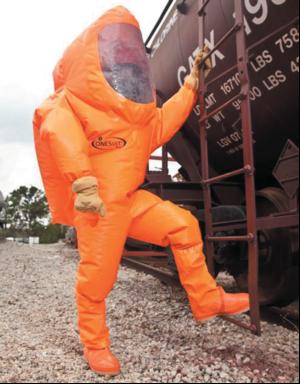Ian Hutcheson weighs up the Total Cost of Ownership of
limited life and reusable gas-tight chemical protective suits
In emergency situations, the use of
fully encapsulated gas-tight chemicalprotective
suits is standarIan Hutcheson weighs up the Total Cost of Ownership of
limited life and reusable gas-tight chemical protective suits
In emergency situations, the use of
fully encapsulated gas-tight chemicalprotective
suits is standard for
monitoring and inspecting the scene as
well as mounting rescue, containment or
clean-up operations. The first choice to
be made in regards to gas-tight chemicalprotective
suits is between limited life and
reusable suits, both of which have similar
safety standards and application areas as
set out by the EN 943-2 certification.
When making this choice ,value for money
has been a common theme as managers try
to squeeze already tight budgets. Limiting
expenditure for new equipment without
sacrificing safety requires informed decision
making.
Too often, the purchase decision is made
on list price alone, but this is just one
portion of the entire cost. The Total Cost of
Ownership (TCO) analysis is a more useful
method for comprehensively determining
the full costs of chemical-protective suits as it
considers indirect costs such as maintenance
and repair costs, which can have a dramatic
impact on the overall spend and lead to
unanticipated budget over-runs.
Direct costs
Acquisition Price
While list price should not be the sole
consideration, it obviously is the starting
point of any cost analysis. The average
price for a reusable suit is €2500-€4000
while a limited life suit runs €1000-€1500.
Indirect factors
Inspection and recertification
To guarantee safety, regular inspection is
crucial for suits intended for multiple
uses, and these inspections have costs that
need to be considered in a TCO analysis.
Reusable suits generally have a shelf life of
5 to 10 years and must be inspected
annually by the manufacturers, which
costs €250-€500 per suit.
The inspection process can take two to
three months and requires additional
investment for replacements suits to
ensure preparedness. Add the cost of
shipping and logistics and inspection and
recertification can be an expensive exercise.
For limited-life suits, inspections are
only needed if the suit has been removed
from its package but not exposed to
chemicals, for example in a false alarm.
Here, inspection procedures are
straightforward as the suit simply needs a
visual inspection and a pressure-test to
ensure it's gas-tight. This operation can be
performed by emergency personnel
themselves or at cost of €100-150 by the
suit providers. If a limited-life suit is
contaminated, it must be disposed of (see
Disposability below).
Most suit usage takes place in practice
sessions, making it advisable to dedicate
suits to training to minimise the cost of
replacing or reinspecting suits that have
never been used in real action.
Maintenance and repair
The repair cost for both limited-life and
reusable suits varies depending on what
needs to be fixed, ranging from €50 to
patch a small cut to many hundreds of
Euros or more. If a suit is significantly
impaired, it may not be worth repairing as
the cost may exceed the acquisition price.
Cleaning
Cleaning of reusable suits is necessary for
personal hygiene reasons and this requires
cleaning areas, access to liquid and
detergents, and drying rooms. As cleaning
is a much less regular occurrence with
limited-life suits, the same work and
infrastructure requirements are not needed.
Storage
Due to their thick, often rubber-like
material composition, reusable suits
typically need to be laid flat or hung since
repeated folding may cause stress-cracking
or seam tape delamination. A large
amount of space is required for storage,
which can be costly and inconvenient.
Limited-life suits are typically lighter,
more flexible and take up significantly less
room so they can be stored folded in their
original package and removed anytime in
a ready-to-use condition.
Disposability
The disposal process for limited-life and
reusable suits is much the same. Both will
need to be decontaminated before
disposal. Once limited-life suits have been
contaminated they must be disposed of
whereas reusable suits can be inspected and
reused. However, it's possible that reusable
suits may need to be destroyed if it's too
risky to decontaminate or costly to repair.
Other factors to consider
Factors, such as user comfort and safety,
cannot be given a monetary value but are
an essential consideration.
For example, the lighter the suit, the
less arduous it is to wear. Some limitedlife
suits, weigh less than their reusable
counterparts and can offer more flexibility.
On the subject of safety, certified
options exist for both types of suits, and
the weighing of various performance
criteria such as flex-cracking and flame
and puncture resistance may need to be
taken into consideration.
Summary
When purchasing chemical-protective
suits, a TCO analysis can be a useful tool to
reveal an accurate picture of overall cost.
Ian Hutcheson is marketing and development
Manager for Saint-Gobain Performance
Plastics


